Rerurn to Romy the Cat's Site
In the Forum: Audio Discussions
In the Thread: It’s mad, mad, mad... electricity.
Post Subject: Purepower 2000: OperationPosted by Romy the Cat on: 12/21/2008
fiogf49gjkf0d
In this section I will brief cover operational parameters of Purepower 2000 regenerator. I do not have a lot of fun to write this section but I feel that for sake of objectivity it is necessary. Also the next section – the sonic observations - might not be understand properly, perhaps even by myself, if some operational parameters will not be considered. So, I will be brief, enumerate just facts, drown necessary alligators, conclusions and proposals and will spent more efforts later on to talk about the Sound of the regenerator. Frankly speaking the regenerator’s Sound, surprisingly much better then it’s measurements…
The new 2000 Purepower is twice taller, heavier but to my surprise is feels better. It has better mass distribution and even visually more proportional as it use to be very deep for it’s height. If you know that ugly feeling of HP’s ProLiant DL360 severs then you know what I mean. The new PurePower has 10 receptacles spread across the whole unit width – very convenient. It still has old coax, telephone, networks receptacles and the rest legacy crap on the unit – I have no idea why APS still maintains it.
The front panel is the very same garbage as it used to be. I call it garbage because the front panel display still show absolutely abstract numbers. The measured and displayed voltages are incorrect and the measured load is incorrect. It is a shame that they did it as it would cost just a few bucks to address this problem for good. What I would like to see in there is not the flimsy, mistakably operating and not visible from 2 feet of distance LDS display but a normal contemporary multi-meter that would show A, V_in, V_out, VA, W, PF and F. Those large, sexy and very comfortable meters cost $70-100 retail and $20 wholesale. For an extra $20-$30 APS might through a board was a few multipliers and to show output distortions numbers in real time. The 2000 Purepower cost $3K. Would I be paying $4K if the unit has a whole set of properly working operation controls on it’s board? Yes, I would. Saying it I have to admit the my Purepower 2000 is installed in a closet with it’s display facing to a wall and its receptacles facing entrance. This brings an interesting view: shell a regenerator like this to be sexy looking shelf-suitable? I feel not. The Purepower regenerator is an impulse machine, sort of a nuclear device, and in shell not be placed right with the rest of audio aliments. So, I do not mind the Purepower to be an ugly duckling sitting in dark corner of the room and doing its job. I would like to see an optional sexy-looking placed-on the rack remote power-monitoring module that will talk with regenerator (by air of by cable) showing all necessary parameters. Did I say that the remote power monitoring module shell have a bypass switch that would kill all regeneration and let the system to be driven straight by power lines?
Next, noise, heat. Heat I feel was not a problem but noise was. Not even the noise from fans but the impulses nose coming from the internals regenerator coils what the unit cares over 1kW. The former 1050 regenerator was better, not because it was less powerful. The former 1050 regenerator had cover that was internally treated with some kind of damping hard rubber – it was very-very good. The new unit has juts metal cover, think one but without damping treatment. I presume it makes better ventilation but does not help with noise. Anyhow, the noise is not so bad and it might derive from my comment. In my room the 2000 PurePower produces as much noise and my DAW that has a few hard drives, fanless PS and one very low speed “special” CPU fan. If I load the regenerator with more than 1kW then it goes louder in my room…. But it not sits in my room but in closet and I do not use more them 1kW.
Voltage drifting. Fixed. The former unit had horrible voltage drift to neutral and in some cases it has 70V-0-50V. The sonic consequences for anyone who knows how the AC voltage affect sound were obvious. The new 2000 unit looks like have no such a problem anymore. It is has 1.2V-0-119.6V that is very acceptable. Still, the phase discipline with PurePower shell be extremely high as any screw up with it immediately destroys sound. I spent many hours to play with it and will be talking about it in the next section dedicated to the sound of the unit.
DC component. To my big surprise the unit pushes out 0.42VDC. It is in a pair of what open power line has but the PurePower is a regenerator, where the DC is coming from it? A big red flag as it had to be tested by APS.
To plug it in. The PurePower 2000, very much as it predecessor, inserts a LOT of very nasty distortions to the line where it plugged in. So, it is absolutely impossible to plug this unit into dedicated audio lines and then to feed from these lines anything else – the line become terminally contaminated with PurePower’s noise. I was trying to plug PurePower into 3kW isolation transformer, it helps a bit, but still the noise goes back to power lines. I did not look further into the problem and plugged the PurePower into my utility line, keeping my audio lines “clean” and free. Take a look. The first image is my dedicated audio line – welcome to the miserly of downtown Boston! The second one is the same line with a PurePower 2000 plugged in to it.
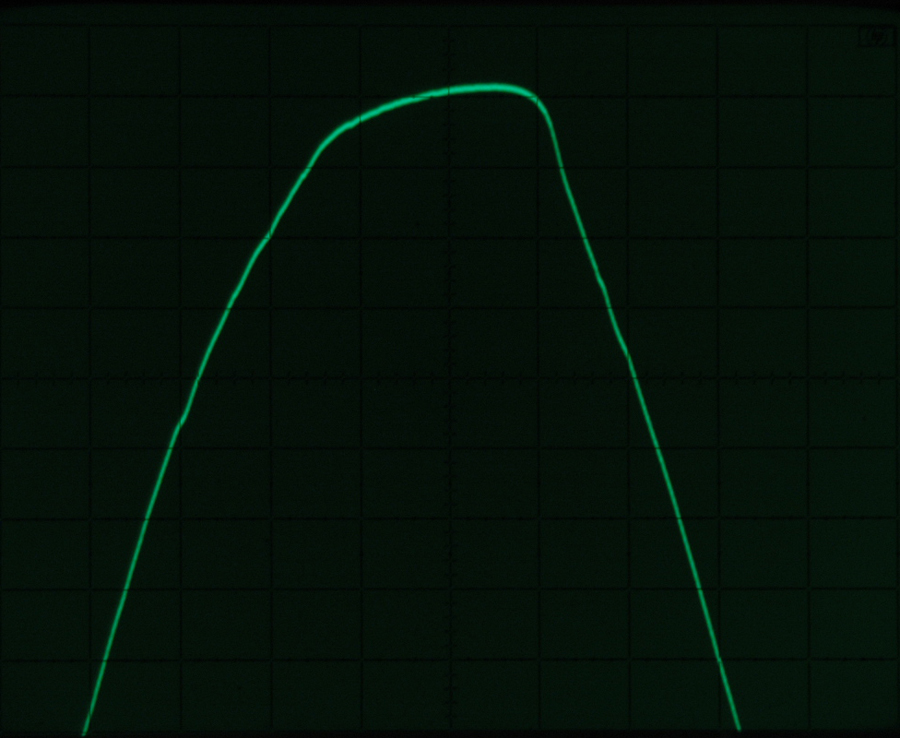

It is 10V per square and you can see that the loaded APS sinks the line (PurePower was sucking 8A and the line impedance is about .45R). It is a bit un-sharp but it is visible that APS returns a lot HF dirt back to is input socket. I do not think that it is bad as all of the regenerators do it but it need to be known and taken under consideration.
Regeneration. Below 30W of load with low power factor (.4-.7) it has very low stabilization but a perfect sinusoid. Approximately at 50W of load the unit begins to develop distortions atop of the wave’s summit. Over 100W the distortions are stabilized and cover the whole summit of the wave. The distortions are at ~3V and 1000Hz, that make 2% of cycle. Let call it PurePower “Nervousness Distortions”. The Nervousness Distortions after 100W is less depending from load of the power factor or load amount – it just always there. It is always there bit it has very stable envelop. The Nervousness will run RMS voltmeter will like crazy but on along scope the Nervousness is very stable and firm. Take a look at the image of the PurePower driving 800W of load with power factor 0.94
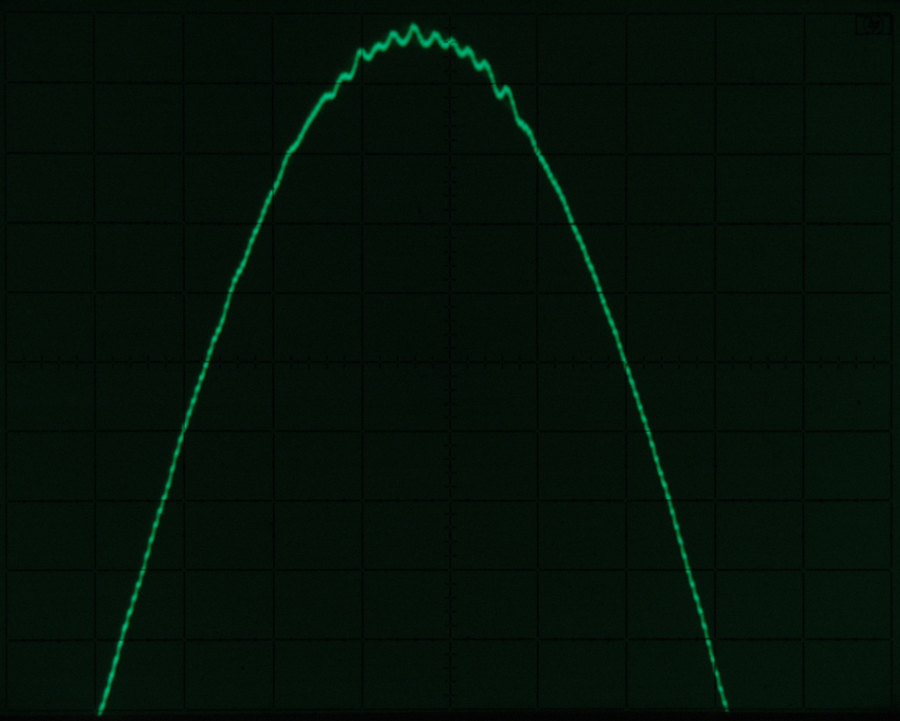
Yes, I know it is ugly but it is what it is. The good part that it is very stable but the former 1050 unit practically had no such a thing. It had the whole summit shifting but not the Nervousness Distortions. I was investigating where this crap was coming from and I discovered that it was there even when the regenerator drived a regular light bulb of 200W. Sucks! My PurePower has an adjuster that allows playing with regenerator’s feedback and presumably to fix this problem. I did a lot of those experiments with no results. The Nervousness Distortions were always there. This made me pissed and angry. Jumping a bit ahead I have to admit that the Nervousness Distortions regardless how ugly it intellectually looks (3V) but it still not impact sound a lot in negative way. Well, it but in much much much lower scale then it might be expected – probably the firm envelop was the positive key. If so then why it made me pissed and angry? Because the Nervousness Distortions are just some kind of stupid fault of APS engineers who make idiotic mistakes in their design. Take a look this image:
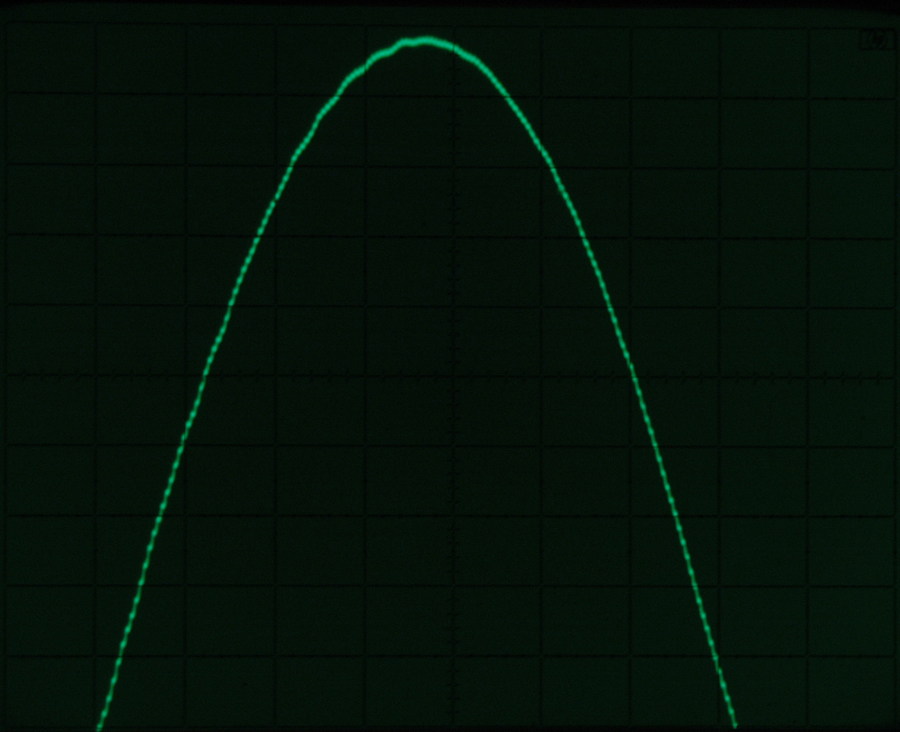
In the image you see the very same load as above but now the regenerator runs from battery. There is practically no Nervousness Distortions. Put the power cord back brings the Nervousness Distortions back. So, the Nervousness Distortions are not the subject of bad regeneration or the feedback-load synchronization but the just not filtered parasitic noise that comes from buttery charger or from input sage. If so, then it shell not be there and it is clearly some kind of bug – why it was discarded by APS I have no idea. Perhaps the ASP used the charger from 1050 unit but the new powerful butteries that do not work well together? I do not know, it hard to say anything without knowing how the unit operates but those problems at the level of a second year of electrical degree student. I am sure that with a few extra caps the nose night be killed.
Load. Well, my bluff with more powerful PurePower was right. PurePower still cannot drive input choke filters as the chokes keep sucking current from wall when there is no voltage already (rectifier’s switching) and this screw up somehow the PurePower’s sinusoid. The new 2000 unit is also the subject of this effect but too much lesser degree. Take a look at the images. This one the first one is the PurePower 1050 driving one 6-channel Melquiades:
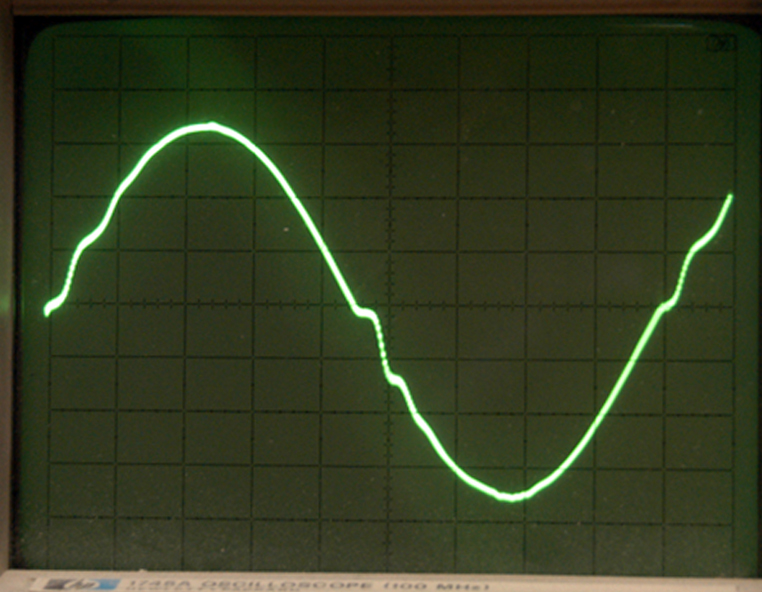
… and the second one is PurePower 2000 driving both 12ch Melquiades, twice of inductive load.
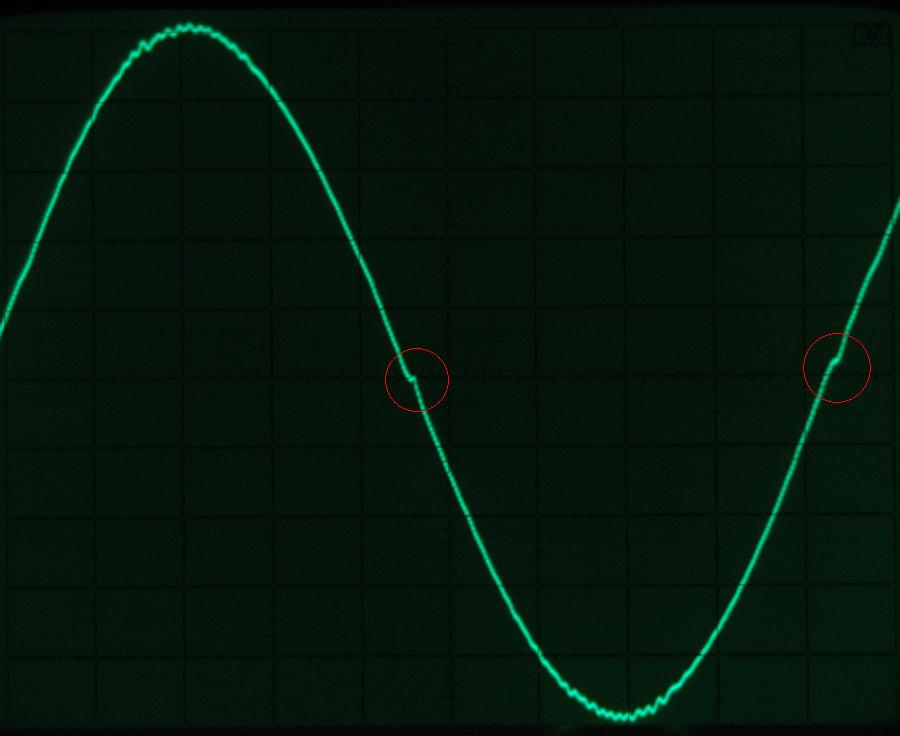
As you see when the voltage goes over “0” then there is glitch on the wave but it is WAY less and actually makes the PurePower 2000 almost able to drive the Milqs. Very good news! I do not know if it is due to some internals changes that were made in circuit or just become more power. if the second then it makes me think about PurePower 3000 or even about 5kW able class D regenerator, that hypothetically shell not even be aggravated with a 700W of Milq’s inductive load.
Generally, with exception of DC component and bad filtration (or whatever else causes the Nervousness Distortions) the PurePower 2000 looks like does what it meant to do, but even with DC component and Nervousness Distortions is does the job. It is reliable and does not blow up – a big accomplishment!!! Whatever the PurePower 2000 is now it did inspire me to talk about it’s sound. The 2000 demonstrates some intersing sonic potency about which I will talking in the next article: “PurePower 2000: Sound”
Rgs, Romy the Cat
PS: This post has factual inaccuracy about DC component. Read my article below with the clarification:
http://www.GoodSoundClub.com/TreeItem.aspx?PostID=9242Rerurn to Romy the Cat's Site